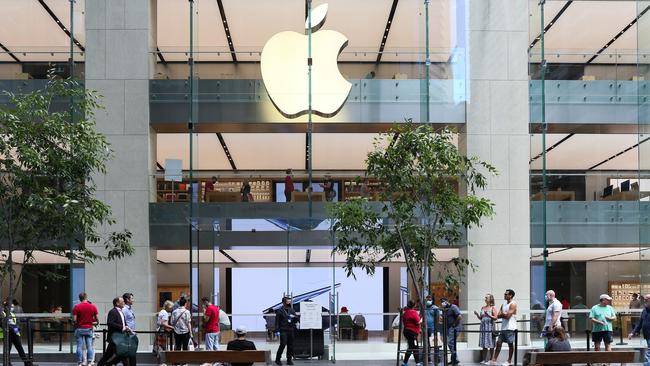Tech tops list of most valuable global brands, new report finds
A list that calculates the value of global brands reveals growth has slowed across multiple sectors. Now is the time for businesses to use creativity to make gains, experts say.

Interbrand’s annual Best Global Brands Report has shown technology, automotive, media and luxury sectors dominate the top 25 spots by number of brands.
According to Interbrand – a brand valuation, experience and strategy company – global brand growth has slowed.
Last year, its report recorded 16 per cent growth across brand value, compared to 5.7 per cent this year.
The report draws on a series of business and brand health metrics to determine the hierarchy of their value, including financial performance and profitability, global reach, the role the brand plays in customer purchasing decisions, and the brands’ competitive strength and customer loyalty.
Interbrand Australia chief executive Nathan Birch told The Growth Agenda the overall slowdown in brand growth is being driven by tightening and volatile economic conditions, which has led to a “play it safe” mentality among executives, a side-effect of which includes companies resorting to short-term “defensive” tactics rather than more innovative measures to drive growth.
To the surprise of few, tech titans Apple, Microsoft, Amazon, Google and Samsung top the list, retaining their spots in its upper echelons since last year.
Apple has remained the top brand for the 11th year in a row. It is the first brand to rise above half a trillion US dollars in brand value, according to the report.
After that, the global automotive brands reign, including Toyota and Mercedes and BMW. However, Coca-Cola and Nike also nabbed spots in the top 10.
In the top 25, technology and media brands continue to prevail, including Facebook, Instagram, Adobe, IBM and YouTube. Notably, three luxury brands – Chanel, Louis Vuitton and Hermes – have earned their place in the top quarter of the list.
Both the automotive and luxury sectors represent the strongest by performance, with sector value rising by 9 per cent and 6.5 per cent respectively.
In the top 20, Disney has been the only brand to decrease in value. Cloud technology company Oracle was a new entrant to the list, while Microsoft was the top 10 highest brand value riser, up 14 per cent on last year’s report.
Nespresso was also a new entrant, taking 98th place.
To find growth, creativity matters
The brand growth slowdown can be attributed to the fact that many companies aren’t making “bold moves” amid economic uncertainty, Mr Birch said.
History shows this trend can result in an over-reliance on performance marketing, the success of which is measured by “clicks” and sales. While businesses need to keep those numbers healthy, studies show when this is prioritised at the cost of brand-led marketing and communication activities, brands can risk their ability to find lasting growth.
“Focusing strictly on defensive tactics when facing economic volatility is an understandable reaction,” Mr Birch said.
“Brands aim to protect themselves in the storm by bunkering down, cutting costs, and avoiding risks.
“However, our research shows that over the nearly 30 years we’ve been analysing the Best Brands, brands bold enough to make calculated innovative bets during downturns can gain market share from struggling competitors.
“They’ll compound longer-term growth by investing smartly while others retreat. Conservative branding in tough times also restricts potential customer relevance and resonance. Changing consumer sentiments and behaviours go undetected if your brand goes quiet or stagnant – the agility to connect to emerging needs declines.”
He added that downturns also force consumers to prioritise, causing them to focus their spending on brands they trust.
“That’s partially why we saw in Covid the gap between the biggest brands and others widen,” Mr Birch said. Apple’s brand value, for example, grew during the pandemic, despite having to close most of its retail stores.
The top-performing brands in the 2023 report share some common traits.
“Data shows that bold brands such as Amazon, Nike, and Apple – that balance responsibility with opportunity setting – gain awareness, relevance and market share during tightened economies by sticking to their identity and purpose,” Mr Birch added.
Media mavens
Brands are increasingly behaving more like media companies and have found growth through producing content and storytelling of their own.
Red Bull, for example, has become known for much more than its energy drink.
Interbrand ranked Red Bull 60 on its 2023 list, up four places from 2022 with a 12 per cent rise in brand value to nearly $13bn. Its brand has become closely connected with sports and has its own TV channel and “Media House”, which includes documentaries about snowboarders, solo mountain climbers and base jumpers.
Behind the numbers, partnerships are also another driver of brand growth.
“I particularly love seeing the growth of Lego – growing its retail footprint, partnering with Levi’s and Adidas, moving into new arenas and becoming as much a content and media business as a toymaker,” Mr Birch said.
Lego was ranked 59th on the list, with its brand value up 10 per cent from last year to $13bn.
Outside of the Interbrand list, some recent brand-led partnerships have attracted more global attention than usual in 2023, thanks to the Barbie movie, when culture at-large seemingly turned entirely pink in the Western world for around a month.
The movie clocked $1.4bn at the box office, but the pink-infused world brand Barbie created was also driven forward by approximately 100 partnerships with brands around the world that leveraged the hype of the film.
Where art thou, Australian brands?
Notably absent on Interbrand’s list are Australian-born companies. Major retail brands such as Telstra, Woolworths, Coles and Wesfarmers have a strong resonance – and relevance – with consumers on Australian shores, but their footprint is largely contained in the local market.
To make Interbrand’s list, at least 30 per cent of a company’s revenue must come from outside its home region. Brands must also have a significant presence in Asia, Europe, and North America, as well as geographic coverage in emerging markets.
Mr Birch thinks the best chance Australian and New Zealand brands have to rise to global brand behemoth heights is via the tech sector.
The likes of accounting software company Xero, collaboration software company Atlassian and graphic design platform Canva, for example, have each built local credibility before expanding overseas.
“For Australian brands to compete globally, sharp differentiation is critical as global consumers face endless choices,” Mr Birch said.
“While we love local brands like RM Williams, which use provenance as a differentiator, building those connections globally will still take some time.
“For brands like Telstra, Coles and Qantas, their history and scale may sustain awareness, but trust and relevance decline severely outside our country in light of the global competition they face. There’s a reason why no airline, supermarket or telecom is on the Top 100 list.”
In the C-suite, a blind spot looms
Brand and business “reputation” has been a 2023 buzzword in the media and marketing industries. Even in a crisis, some brands are more resilient.
Amid the tumult that has engulfed Qantas, branding expert and former marketing professor Mark Ritson recently argued in The Australian:
“Brands, despite what you might have read recently, aren’t these vulnerable, ephemeral things that lose favour, then fortune, in the blink of an eye.
“Quite the opposite. Big brands are tough old things that ride out short-term sensationalism every time.”
Mr Birch agrees with this observation, and thinks that ignoring the long-term value of brands – and its influence – could be a mistake.
“Nike, Samsung, YouTube, and Apple have all suffered crises – but their investment in the good times in the brand trust, engagement, and affinity – not just awareness through ad campaigns – insulates them better in the bad times,” Mr Birch said.
“That’s the most significant blind spot for Australian C-suite today – the understanding of brand and its strategic importance – a fundamental lack of understanding that investing in your brand beyond that of marketing messages is the best risk mitigation policy you have at your disposal.
“The C-suite must see the brand as a revenue and profit driver, rather than a cost centre. Brand drives preference and should permeate everything a brand does, including governance and operations, risk management, talent retention, and acquisition.”







